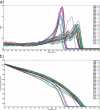Differentiation of Community-Associated and Livestock-Associated Methicillin-Resistant Staphylococcus aureus Isolates and Identification of spa Types by Use of PCR and High-Resolution Melt Curve Analysis
- PMID: 32132185
- PMCID: PMC7180259
- DOI: 10.1128/JCM.02088-19
Differentiation of Community-Associated and Livestock-Associated Methicillin-Resistant Staphylococcus aureus Isolates and Identification of spa Types by Use of PCR and High-Resolution Melt Curve Analysis
Abstract
Infections due to methicillin-resistant Staphylococcus aureus (MRSA) are present worldwide and represent a major public health concern. The capability of PCR followed by high-resolution melt (HRM) curve analysis for the detection of community-associated and livestock-associated MRSA strains and the identification of staphylococcal protein A (spa) locus was evaluated in 74 MRSA samples which were isolated from the environment, humans, and pigs on a single piggery. PCR-HRM curve analysis identified four spa types among MRSA samples and differentiated MRSA strains accordingly. A nonsubjective differentiation model was developed according to genetic confidence percentage values produced by tested samples, which did not require visual interpretation of HRM curve results. The test was carried out at different settings, and result data were reanalyzed and confirmed with DNA sequencing. PCR-HRM curve analysis proved to be a robust and reliable test for spa typing and can be used as a tool in epidemiological studies.
Keywords: MRSA; PCR; high-resolution melt curve analysis.
Copyright © 2020 American Society for Microbiology.
Figures





References
-
- Coombs GW, Nimmo GR, Pearson JC, Collignon PJ, Bell JM, McLaws ML, Christiansen KJ, Turnidge JD, Australian Group on Antimicrobial Resistance. 2013. Australian Group on Antimicrobial Resistance Hospital-onset Staphylococcus aureus Surveillance Programme annual report, 2011. Commun Dis Intell Q Rep 37:E210–E218. - PubMed
-
- Dantes R, Emerging Infections Program–Active Bacterial Core Surveillance MRSA Surveillance Investigators, Mu Y, Belflower R, Aragon D, Dumyati G, Harrison LH, Lessa FC, Lynfield R, Nadle J, Petit S, Ray SM, Schaffner W, Townes J, Fridkin S. 2013. National burden of invasive methicillin-resistant Staphylococcus aureus infections, United States, 2011. JAMA Intern Med 173:1970–1978. doi:10.1001/jamainternmed.2013.10423. - DOI - PMC - PubMed
Publication types
MeSH terms
Substances
LinkOut - more resources
Full Text Sources
Medical

